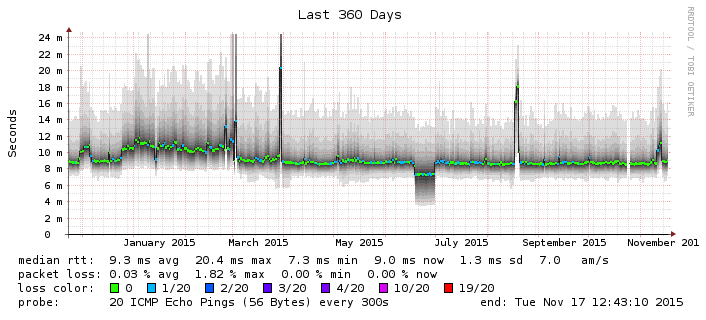
 |
| News | Profile | Code | Photography | Looking Glass | Projects | System Statistics | Uncategorized |
Blog |
Unlike most folks, I value first-hop latency on residential networks over gobs of bandwidth. Why? It's likely to have a larger impact to my web browsing experience than bandwidth, in many cases.
I've got 50 Mbps downstream and 10 Mbps upstream at home via Comcast Business, at the moment. Unfortunately, I pay a bit for it because I have a static IPv4 /29 prefix. Anyway, the 50 Mbps downstream is good enough for streaming and downloading most content (20 Mbps would work, too, I guess). The 10 Mbps is mildly sufficient for me but gets a little painful when uploading videos or transferring large files via rsync over SSH.
If I could pay $5 or $10 more per month for 100 Mbps downstream, I probably wouldn't bother. Excluding video-rich sites, I don't see more than 4-5 Mbps at peak when loading web pages and browsing the web.
However, I'd pay more to reduce the first-hop latency since most web content is coming from CDN nodes that are nearby. Lower latency impacts the initial stages of TCP significantly and can have a large impact on transferring web content quickly over short-lived connections.
Comcast's got an Akamai CDN node on-net, which is about 10 ms from me:
(valen:12:31)% mtr --report --report-cycles=10 --report-wide www.akamai.com. Start: Tue Nov 17 12:31:34 2015 HOST: valen Loss% Snt Last Avg Best Wrst StDev 1.|-- 2001:558:4082:48::1 10.0% 10 8.3 24.3 8.3 133.6 41.0 2.|-- te-0-2-0-5-sur03.burien.wa.seattle.comcast.net 0.0% 10 13.6 10.6 7.8 13.6 1.7 3.|-- be-21-ar01.seattle.wa.seattle.comcast.net 0.0% 10 10.0 10.8 9.2 13.8 1.5 4.|-- be-33650-cr02.seattle.wa.ibone.comcast.net 60.0% 10 14.2 12.6 11.3 14.2 1.0 5.|-- hu-0-11-0-0-pe04.seattle.wa.ibone.comcast.net 0.0% 10 10.3 11.3 9.1 16.6 2.1 6.|-- as20940-2-c.seattle.wa.ibone.comcast.net 0.0% 10 9.7 11.5 9.7 14.4 1.3 7.|-- 2600:1409:a:1a0::22d9 0.0% 10 9.6 13.3 9.1 24.9 5.0
While I live in West Seattle, apparently the CMTS I use is down south in Burien, WA, likely due to the geography of the region. It takes about ~7-8 ms to get to the CMTS. This is my first hop latency (hop 1 is my Comcast modem since it's in L3 mode for the static IPv4 assignment). As you can see above, the bulk of my latency to the Akamai cache is due to the first hop. DOCSIS has a request/grant system (see slide 16 in this PDF) for accessing upstream bandwidth, which adds an extra "round trip" to the communication from my cable modem to the CMTS. If that were somehow lowered to 1 ms or so (GPON?), I'm sure most of the web would "feel" faster since my latency to the cache would be around 2-3 ms.
As another example, Google doesn't have a cache on Comcast's network but they aren't too far away:
(valen:12:31)% mtr --report --report-cycles=10 --report-wide www.google.com. Start: Tue Nov 17 12:32:08 2015 HOST: valen Loss% Snt Last Avg Best Wrst StDev 1.|-- 2001:558:4082:48::1 30.0% 10 27.5 13.4 9.2 27.5 6.5 2.|-- te-0-2-0-5-sur02.burien.wa.seattle.comcast.net 0.0% 10 8.1 9.8 8.1 11.6 0.8 3.|-- be-21-ar01.burien.wa.seattle.comcast.net 0.0% 10 9.3 9.2 8.0 10.2 0.6 4.|-- he-0-13-0-0-ar01.seattle.wa.seattle.comcast.net 0.0% 10 11.2 10.3 8.7 14.6 1.6 5.|-- be-33650-cr02.seattle.wa.ibone.comcast.net 70.0% 10 13.6 12.5 10.5 13.6 1.6 6.|-- 2001:558:0:f510::2 60.0% 10 13.3 12.0 9.8 13.3 1.4 7.|-- 2001:559::cfa 0.0% 10 9.4 11.7 8.6 28.9 6.1 8.|-- 2001:4860::1:0:9aa5 0.0% 10 9.7 11.0 8.8 14.0 1.8 9.|-- 2001:4860::8:0:6999 0.0% 10 10.2 16.4 9.3 50.7 12.6 10.|-- 2001:4860::8:0:61e1 0.0% 10 14.4 17.0 12.7 44.6 9.7 11.|-- 2001:4860::8:0:924a 0.0% 10 16.1 17.0 15.0 20.8 1.5 12.|-- 2001:4860::2:0:90fe 0.0% 10 16.3 17.6 15.7 22.0 1.8 13.|-- ??? 100.0 10 0.0 0.0 0.0 0.0 0.0 14.|-- pb-in-x93.1e100.net 0.0% 10 28.1 18.8 14.9 28.1 4.6
That 15 ms to the Google content node could be reduced to around 7-8 ms if my first-hop latency went away, too!
It just so happens that I graph my first-hop latency to the CMTS using SmokePing. Here's a graph over the last year:

It doesn't change too much. I'm curious what happened in June to drop my latency by what looks to be 1-1.5 ms, but only Comcast would really know. The heightened latency in January and February were due to a memory leak in my cable modem, I think.
Also, low latency is obviously good for gaming, which doesn't really apply to me, and other interactive applications like SSH. vimdiff(1), for example, is pretty painful on a high latency connection due to the way if repaints the entire terminal window.
To compare my Comcast connection with other residential technologies, here's what I've seen for first hop latencies:
Obviously, the lowest latency is going to come from an Ethernet-based service, something like wave G (formerly condointernet). I'm fairly sure it's limited to apartments and condiminiums in major metropolitan areas like downtown Seattle.
So, in a nutshell, that's why I'm not impressed with 300 Mbps vs. 50 Mbps DOCSIS service, a 50 Mbps Ethernet DIA service might be appealing.
New comments are currently disabled for this entry.
     |
This HTML for this page was generated in 0.001 seconds. |